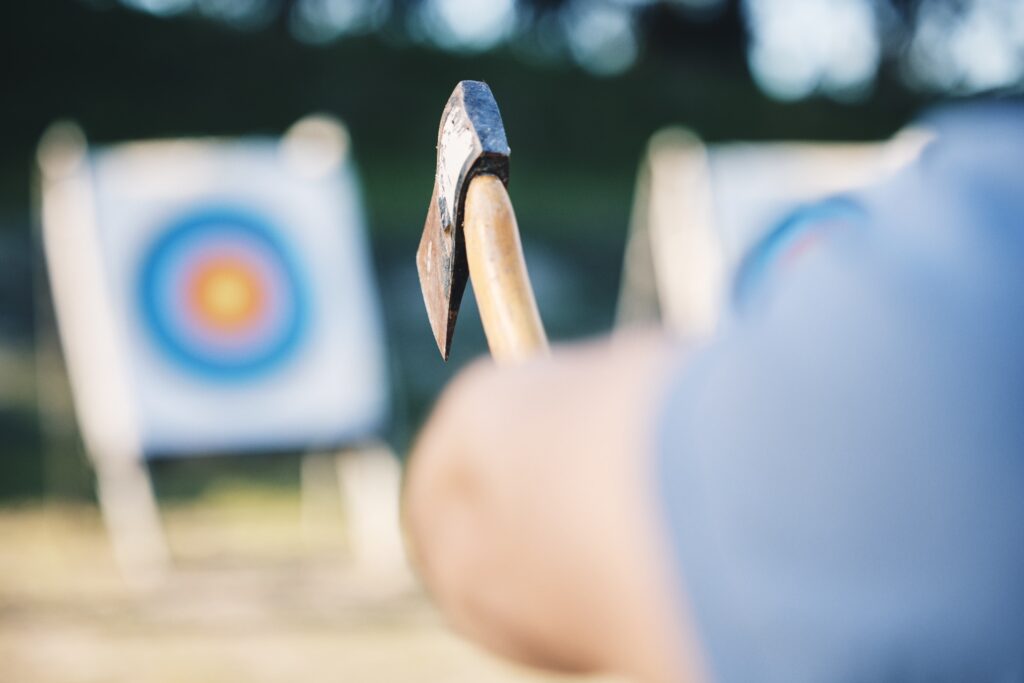Axe-throwing, once relegated to lumberjack competitions and historical reenactments, has become a popular and accessible recreational activity. Whether you’re seeking a new hobby, a unique social experience, or a thrilling way to unwind, axe-throwing offers a blend of skill, excitement, and camaraderie. For beginners eager to step into the world of flying axes, understanding the fundamentals and avoiding common mistakes is key to a safe and enjoyable experience. In this blog post, we’ll explore the art of axe-throwing for beginners, highlighting common pitfalls to sidestep on your journey to mastering this captivating activity.

1. Neglecting Safety Measures: The First and Foremost Mistake
The cardinal sin in axe-throwing, and any recreational activity for that matter, is neglecting safety measures. Safety is paramount, and beginners must adhere to venue rules and guidelines. This includes wearing closed-toe shoes, using safety gear provided by the venue (such as safety glasses), and listening attentively to safety briefings. Ignoring these fundamental precautions not only jeopardizes your well-being but also disrupts the collective safety of everyone in the venue.
2. Incorrect Grip: Firm but Not Forceful
One of the most common mistakes for beginners is adopting an incorrect grip on the axe. While a firm grip is essential for control, gripping the axe too forcefully can hinder your throwing technique. Focus on a balanced grip that provides control without excessive tension. A grip that is too tight can lead to over-rotation or erratic throws, diminishing your accuracy.
3. Inconsistent Stance: Stability Matters
Achieving a stable and consistent stance is crucial for accurate axe-throwing. Beginners often make the mistake of adopting an inconsistent or unbalanced stance. Ensure your feet are shoulder-width apart, perpendicular to the target. Distribute your weight evenly and maintain a comfortable yet sturdy posture. Consistency in your stance lays the foundation for developing a reliable throwing technique.
4. Overestimating Strength: It's About Technique
Axe-throwing is more about technique than sheer strength. Beginners often make the mistake of relying solely on arm strength to propel the axe. Instead, focus on mastering the proper throwing technique, utilizing your body’s natural motion. The power for a successful throw comes from a coordinated movement involving your hips, shoulders, and arms, not just brute strength.
5. Inconsistent Release: Timing is Everything
Achieving a consistent release is a challenge for beginners. Timing is crucial, and releasing the axe at the right moment contributes to accuracy. Avoid the mistake of releasing too early or too late, as this can result in over- or under-rotation. Practice the release in tandem with your body’s natural motion to find the sweet spot that ensures a smooth and controlled flight.

6. Overthrowing: Precision Trumps Power
Beginners often fall into the trap of trying to throw the axe too forcefully. Overthrowing not only compromises accuracy but also increases the risk of injury. Focus on precision rather than power. Start with controlled throws, gradually increasing your intensity as you develop your technique. A well-controlled and accurate throw is more impressive than a powerful but errant one.
7. Ignoring Rotation: Finding the Right Spin
Proper rotation is a critical aspect of axe-throwing. Beginners may make the mistake of ignoring the importance of spin and rotation. Experiment with different grips and release points to find the rotation that works best for you. A consistent and controlled spin contributes to accurate throws and increases the likelihood of hitting the bullseye.
8. Lack of Follow-Through: Completing the Motion
A common mistake among beginners is neglecting the follow-through. After releasing the axe, it’s essential to complete the throwing motion with a smooth follow-through. Failing to follow through can disrupt the trajectory of the axe and impact accuracy. Ensure that your throwing hand continues its natural path even after the axe has left your grip.
9. Not Seeking Guidance: Learning in Isolation
Axe-throwing is a skill that benefits from guidance and instruction. Beginners often make the mistake of trying to learn in isolation without seeking guidance from experienced throwers or instructors. Many venues offer introductory lessons, and instructors can provide valuable insights into proper techniques, safety measures, and common pitfalls. Don’t hesitate to seek guidance to accelerate your learning curve.
10. Getting Frustrated: Patience is a Virtue
Axe-throwing, like any skill-based activity, requires patience and practice. Beginners often make the mistake of getting frustrated after a few unsuccessful throws. Understand that mastery takes time, and each throw, whether successful or not, is an opportunity to learn. Embrace the learning process, celebrate small victories, and maintain a positive mindset as you navigate the challenges of axe-throwing.

From Novice to Axepert
Embarking on the journey of axe-throwing as a beginner is an exciting endeavor filled with challenges and triumphs. By avoiding common mistakes, prioritizing safety, and embracing the learning process, beginners can progress from novices to experts. Whether you’re drawn to the thrill of hitting the bullseye or simply seeking a unique and enjoyable activity, axe-throwing offers a blend of skill development and entertainment that makes it an unforgettable experience for beginners and seasoned throwers alike. Check out the Propel Axe blog for more tips on how to get started with axe-throwing!


 720-330-9755
720-330-9755
